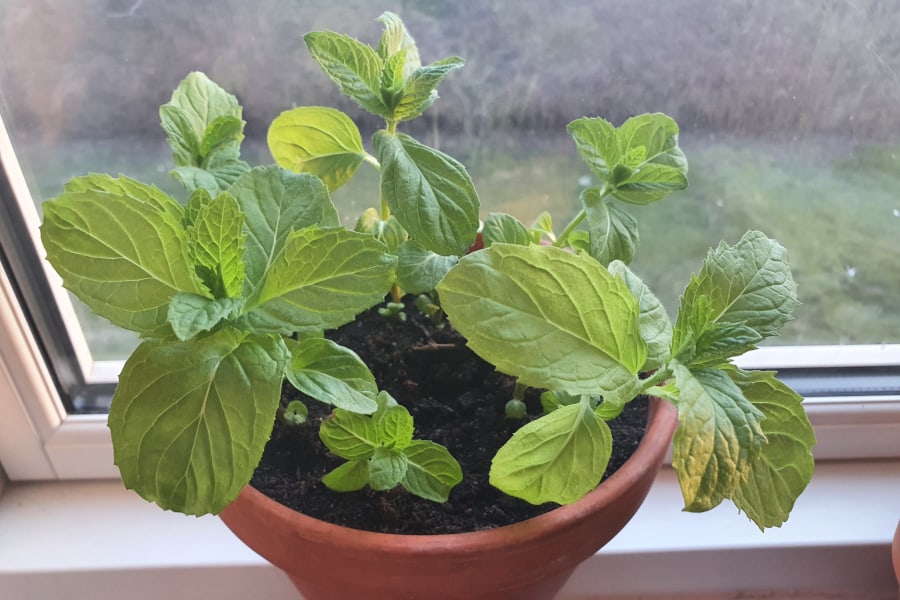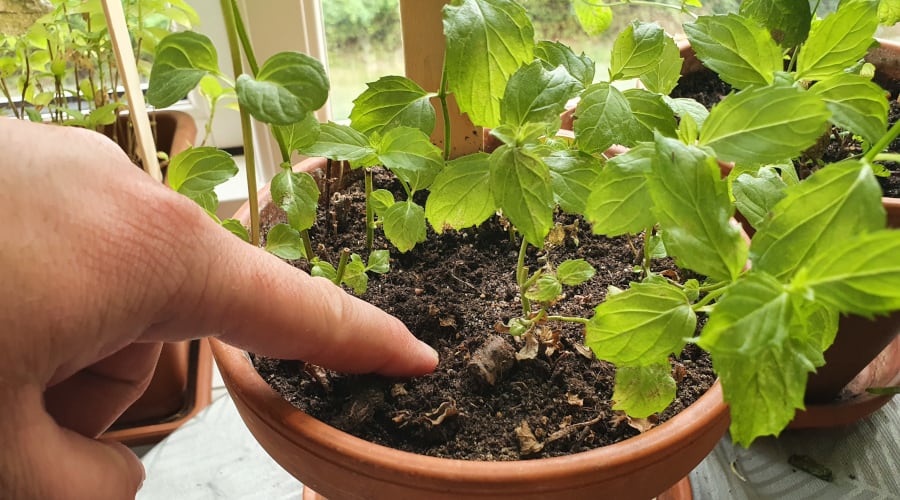This post contains affiliate links.
How long can mint plants live? I reached out to a gardener with over 50 years of experience and asked him that question. This is what he told me.
Mint plants can technically live forever, although they require some maintenance. Potted mint requires more maintenance than mint growing directly in the ground since it has less growing space, but both can live forever if maintained correctly.
In this article, I will go into more detail about how long mint plants live and how you should maintain them to help them live forever.

Can Mint Plants Live Forever? Gardener Explains
When I have a gardening-related question that I don’t know the answer to, I like to call or visit some gardening centers or plant nurseries, where I can have a chat with a true expert.
To find out how long mint plants can live, I called one of my favorite garden centers and got to talk to one of their experts with over 50 years of gardening experience. Suffice to say, he knew what he was talking about.
How long mint plants can live depends entirely on their growing conditions, but with proper care and conditions, mint plants can live and grow forever. Mint is a perennial plant, so as long as it has good enough conditions, it will grow back year after year.
Arne, gardener with over 50 years of experience.
As a perennial plant, mint will come back year after year. The green part of the plant (stems and leaves) will become dry and die when the temperatures dip below the freezing point, but the roots will usually survive since they are protected by a layer of soil, and when it begins warm up again in the spring, new growth will appear from the roots.
Arne (the expert gardener I spoke to) made it very clear that mint won’t live forever without proper care.
If you just plant your mint in a pot and water it as needed, it will not live forever as it will eventually run out of room for its roots in the pot. Mint planted in the ground will live longer than potted mint without any special care but will usually also run out of room and become self-destructive.
The reason why mint becomes self-destructive after a while is that the roots run out of space, and when that happens, they can’t obtain water and nutrients efficiently enough. So what should you do to keep your mint alive forever? I cover that below, so keep reading.
Do This to Keep Your Mint Alive Forever (6 Easy Tips)

Mint plants can easily live for several years without any special care, but if you want to keep your mint alive forever, there are a few things you need to know about and do.
Here are six easy things you can do to extend your mint plant’s life or even make it live forever.
1. Split the plant every few years
The primary reason why mint plants don’t live forever (poor growing conditions aside) is that their roots run out of room. This is especially true for potted mint but also often true for mint growing directly in the ground, although mint in the ground will keep spreading outwards horizontally, so the roots at the center will run out of room first.
Luckily, there is a very easy solution to mint roots running out of space, especially if you grow your mint in a pot.
Before I wrote this article, I spoke to a very experienced gardener from a local garden center, who taught me how to deal with this problem. This is what he told me.
If your mint plant’s roots are running out of room to grow, you should split the plant. The easiest way to split a mint plant is by using your hands to separate the roots or a clean saw to cut it vertically, that way splitting it into two or more parts.
When you split your mint, try to keep as many roots intact as possible, but also know that it won’t hurt your mint if you cut or break some of them. Just make sure every part has as many roots as possible left on them after you split them. Plant the parts individually to give them the room they need to live for several more years.
How often you need to split your mint depends on its size, how much sunlight it gets, and more, but a good general rule of thumb is to do it every two years if you grow it in a pot that is 12-inch (30 cm) wide. The larger the pot, the longer the plant can go without needing to be split up.
If you keep splitting your mint plant, as I explained here, when it is needed (and otherwise take good care of it), you can keep it alive forever.
2. Replenish the soil every year
For mint to live and grow for a long time, it needs proper, well-drained, and nutrient-rich soil.
As mint grows, it will use up more and more of the nutrients in the soil, so you need to replenish the soil every now and then. I recommend doing it every year.
To replenish the soil your mint is growing in, either mix some fresh, nutrient-rich soil or compost into the soil every year or fertilize it with a slow-release, complete 16-16-16 fertilizer that is mixed into the soil once at the beginning of spring.
This article from Utah State University’s Horticulture extension has a more detailed explanation of how to fertilize your mint as well as some more good information. No matter what fertilizer you use, never use more than the recommended amount, as that can damage the plant.
Another easy thing you can do to keep nutrients in the soil is adding a layer of mulch on top of it. As it breaks down and decomposes, the organic material can be used as nutrients by the plants.
Doing some or all of these things will help keep your mint plant alive for much longer, or potentially even forever if you keep doing it when needed and when combined with some of the other tips I share here.
3. Grow your mint in a large pot
Growing your mint in a large pot will not by itself keep it alive forever, but it will certainly help it live for longer, and if you split it up once in a while, you can actually keep it alive forever.
As a general rule, mint grows better the larger the pot is. Mint spreads horizontally, so a larger pot allows it to spread more and become bigger and more productive. The ideal pot size for mint is 12 inches (30 cm) or larger.
Pot size is not the only thing you should consider when choosing a pot for your mint. The material is also very important as it affects how well the soil is being oxygenated, how good drainage it has, and more. I have another post (here) to help you pick the best pot for your mint.
4. Give your mint a heavy pruning every year
There are several reasons why you should prune your mint regularly, but perhaps the most important reason is that it keeps the mint alive and growing for longer.
I have a full guide on how to prune mint, which you can find on this link, but if you just want the quick version, here you go:
Prune your mint by cutting it back by about half once a year. This promotes new, green growth and makes the plant grow back bushier and more productive than before. It is also a good idea to harvest your mint frequently by pinching off stems or new shoots, as that also promotes growth.
You can often just pinch stems or new shoots off with your fingers, but for thicker stems, I recommend using clean and sharp pruning shears to avoid damaging the plant.
There are a lot of different opinions on what the best time of the year to prune mint is. I like to do it in the summer just as the flowers begin to appear, as it delays flowering and extends the growing and production period.
It is also important to cut your mint plants back to about an inch (2.5 cm) above the ground some time between the end of the growing season and the start of a new one. You can read more about how to do it and why it is important on this link.
5. Take cuttings from your mint and propagate them
Propagation is a method for cloning your mint plant and growing another genetically identical plant from a cutting from the original plant. You can technically use this method to keep mint plants alive forever.
There are two ways to propagate mint. You can either do it from a cutting or a root.
The easiest way to propagate mint from cuttings is to cut stems that are about 5 inches (12.5 cm) or longer off the plant, remove all leaves except about four at the top, and submerge the stem (but not the leaves) in water for 2-3 weeks. Then the stems will have grown roots and can be planted in soil as new plants.
To propagate mint from a root, simply cover a mint root that is at least 5 inches (12.5 cm) with a few inches of good and nutrient-rich soil. After a few weeks, you should be able to see some new, green growth.
When you propagate a mint plant with either of these two methods, the new plant is guaranteed to be of the same genetic makeup as the plant you took the cutting or root from.
Other than being a great method for cloning your mint and keeping it alive forever, propagating it is also a great way to grow more mint in different places for free.
As a nice little bonus, the mint plant you take cuttings from will become bushier and more productive as you take cuttings from it. You can read more about this in the article on this link, where I share 8 tricks to make your mint plants bushier and more productive.
6. Give your mint full sun and frequent watering
Mint is a versatile plant that can grow well under different conditions, but the better conditions it has, the better it grows and the longer it lives. Here is what you should know.
As a general rule, mint grows best in full sun but can also grow well in partial shade. Mint needs frequent watering, and the best way to tell if a mint plant needs water is to feel if the top inch of the soil is dry and water it if it is.
These are the most important things you should know about when it comes to sunlight and watering for your mint, but there is a bit more to it. You can read a complete guide on how to give your mint the best growing conditions in this article, where I cover everything, including sunlight, watering, temperature, nutrients, soil, spacing, and more.

